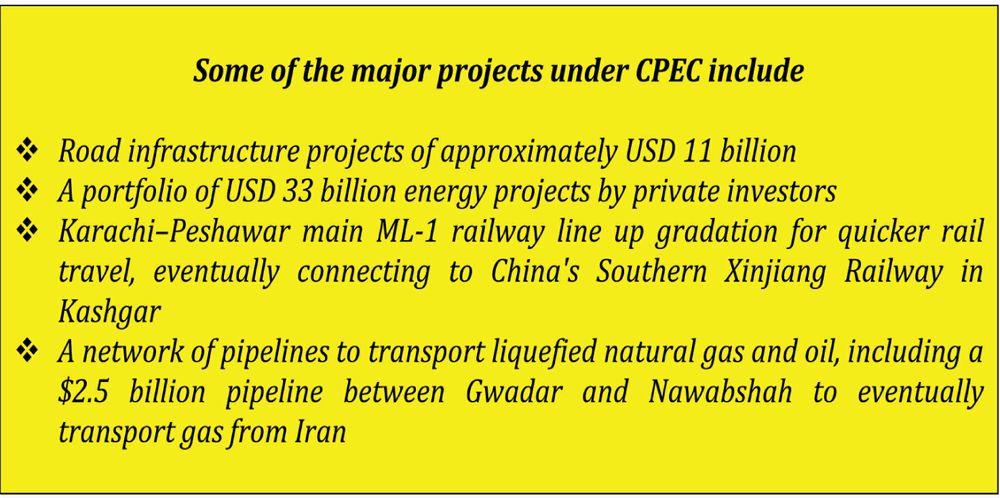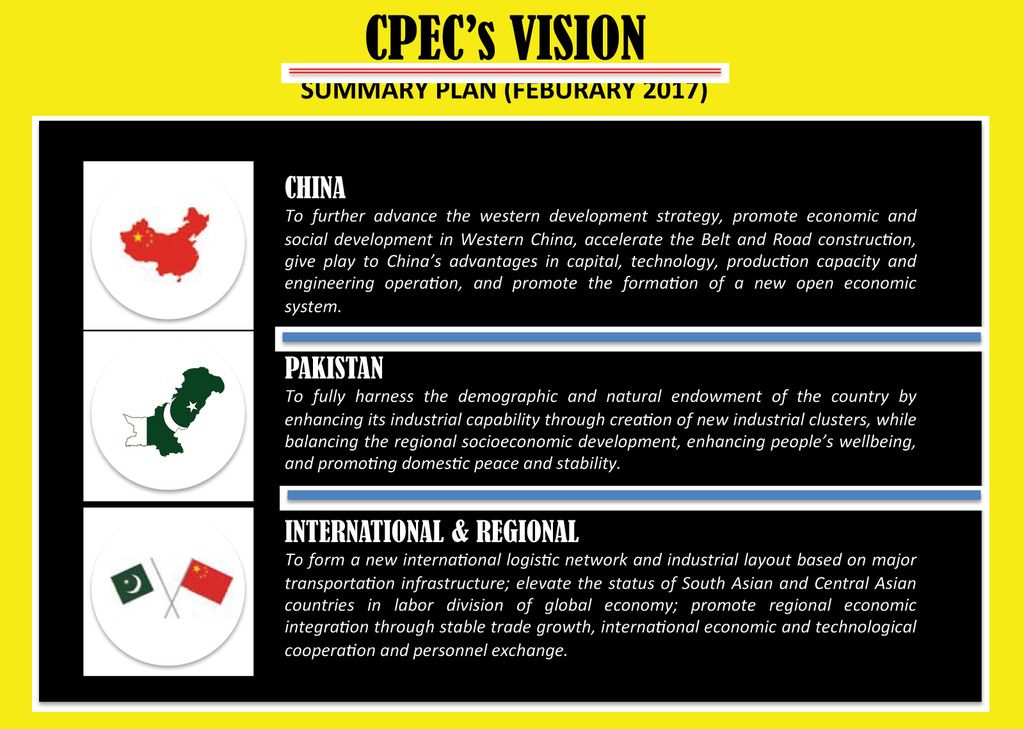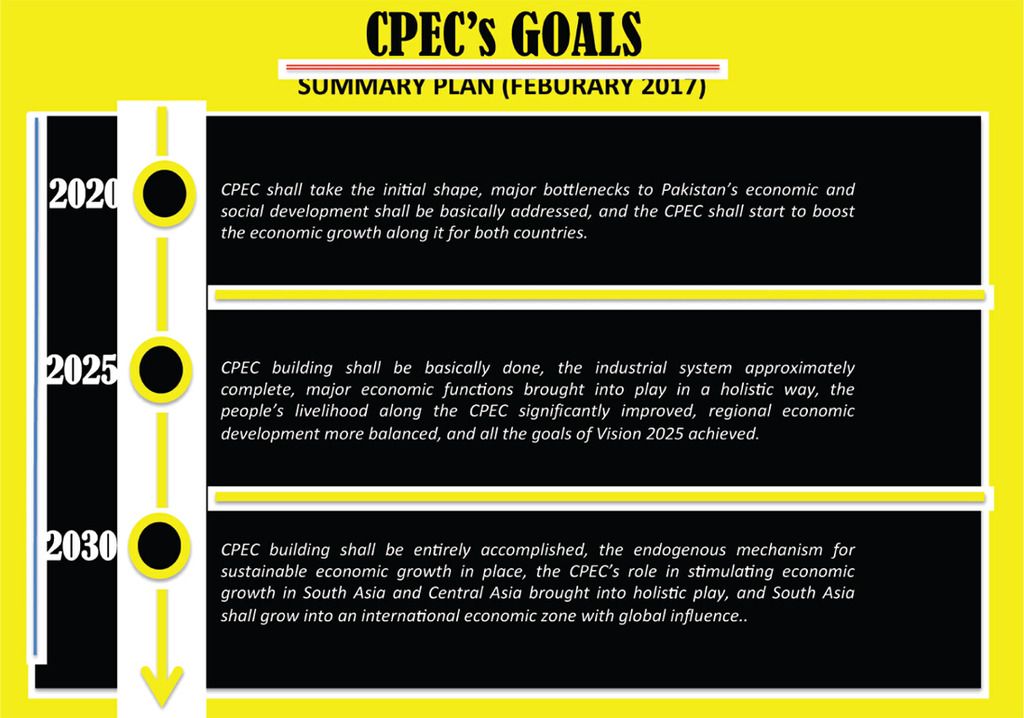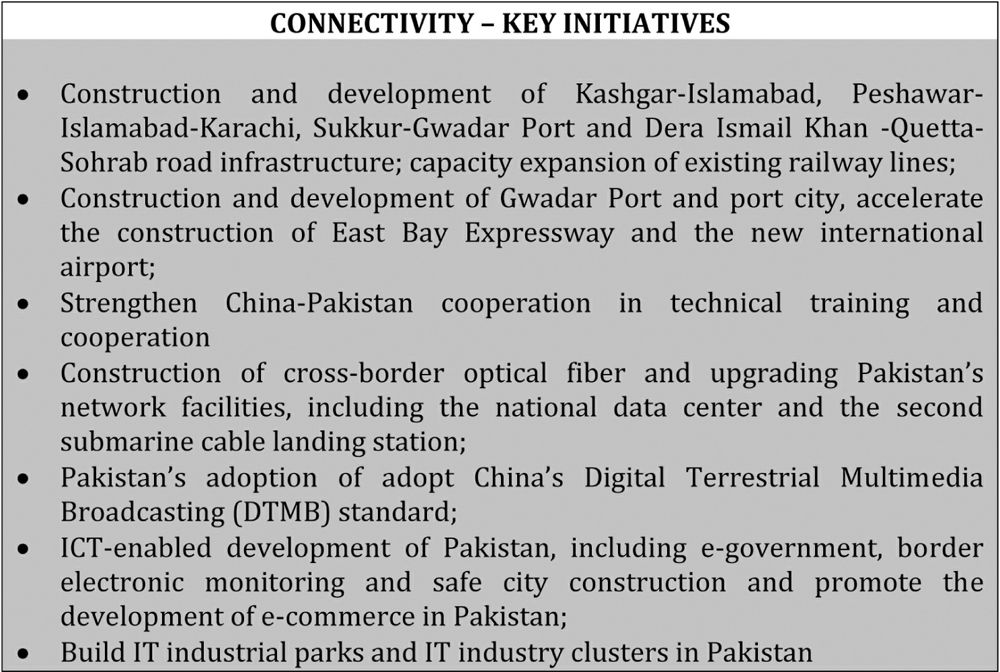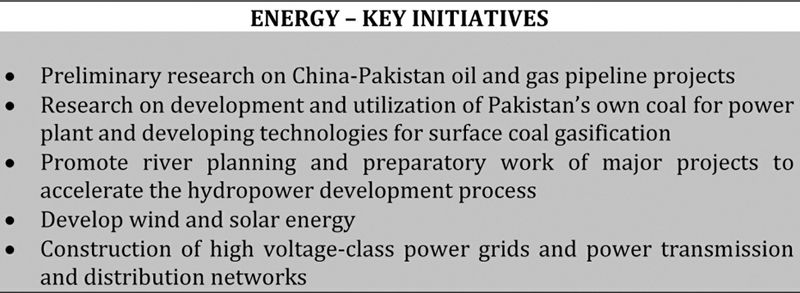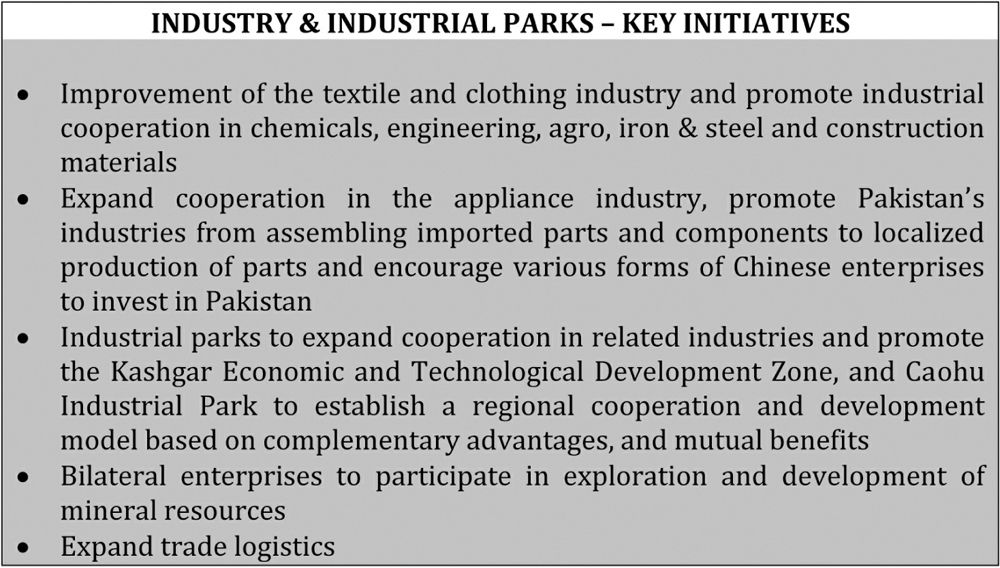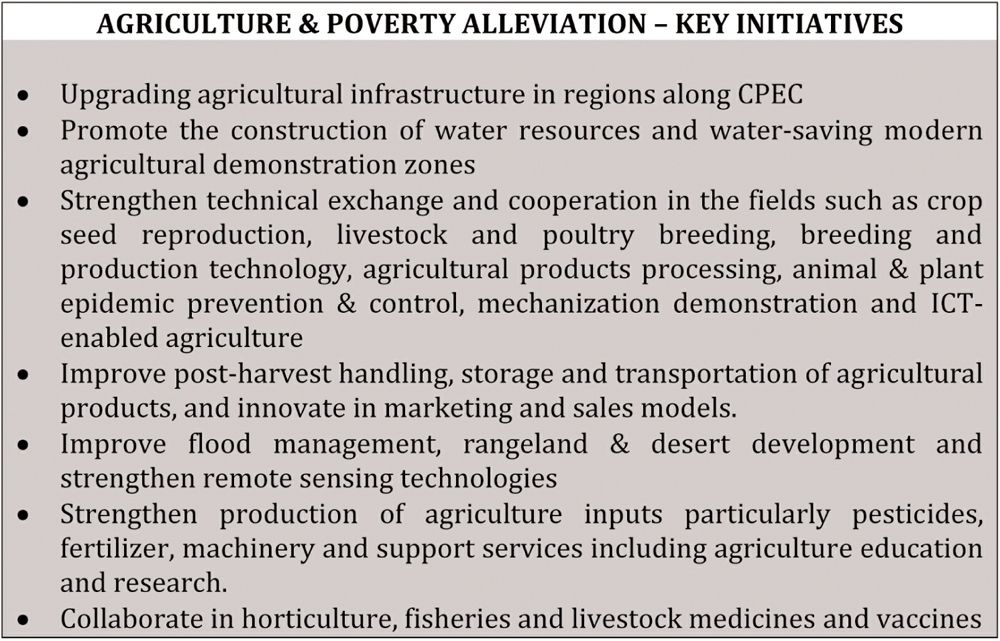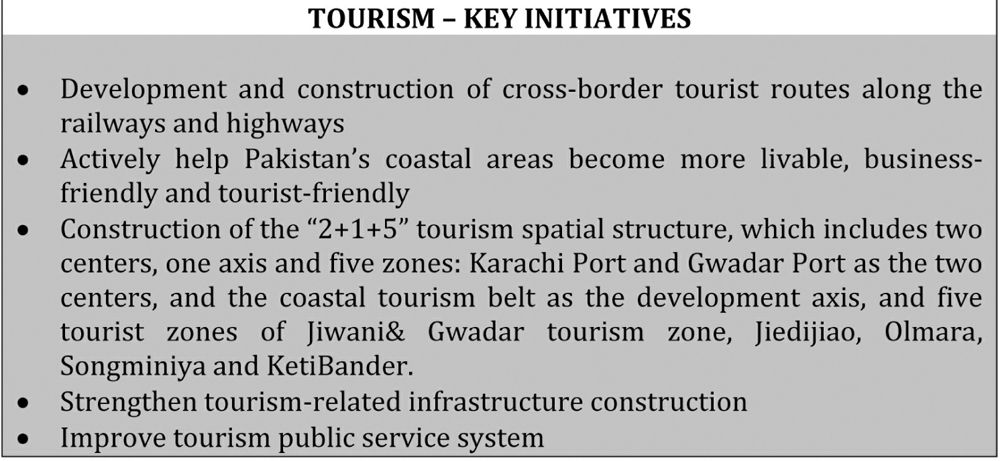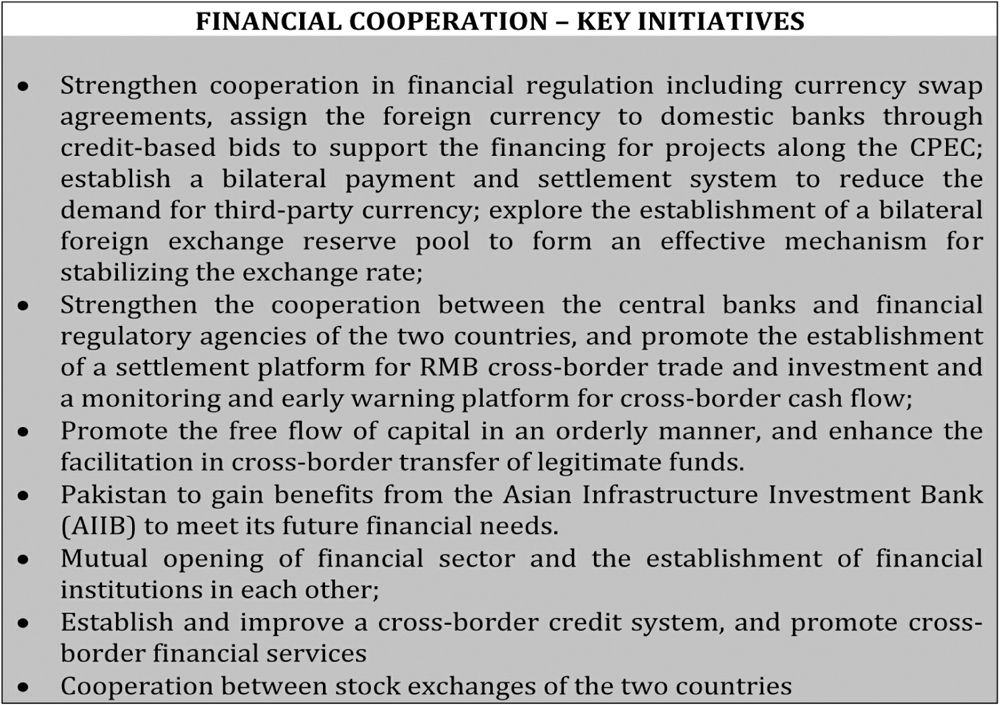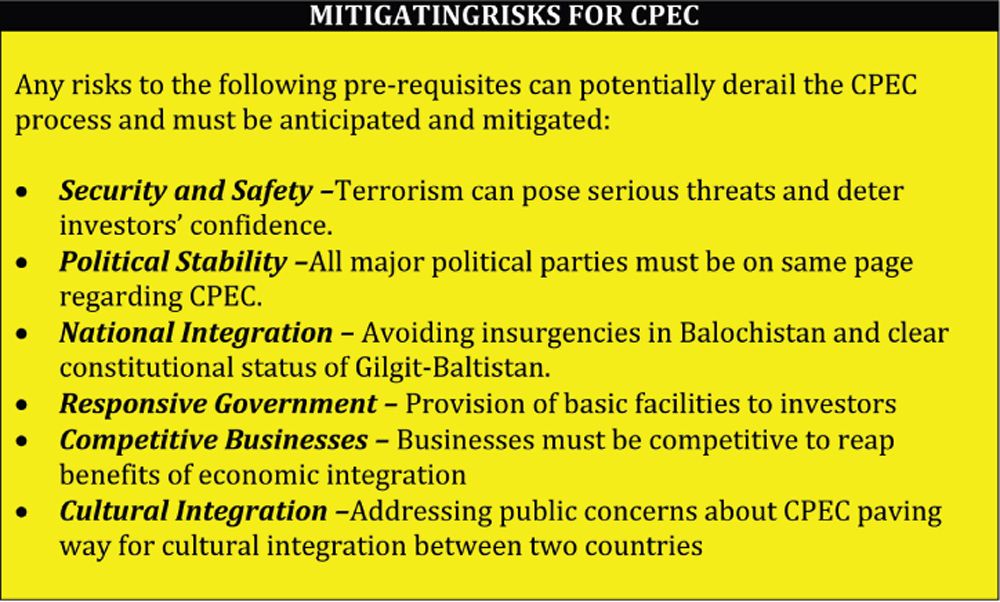CSS Forums
Saturday, April 20, 2024
06:11 PM (GMT +5)
06:11 PM (GMT +5)
|
|||||||
| News & Articles Here you can share News and Articles that you consider important for the exam |
 |
Share Thread:
 Facebook
Facebook
 Twitter
Twitter
 Google+
Google+
|
|
|
LinkBack | Thread Tools | Search this Thread |
|
#11
|
||||
|
||||
|
CPEC and the provinces THE government finds itself battling on three fronts. Civil-military relations are said to be at their lowest ebb in years, a main opposition party is gearing itself to lay siege to the capital, and inter-provincial tensions over the distribution of federal resources and CPEC projects are escalating. The first problem is recurring, and regardless of what many think about it, is largely beyond the control of this or any other civilian government. The second battle, that with Imran Khan on the other hand, is largely of the government’s own making. Seven months on from the Panama Papers leaks, the PML-N leadership has done little by way of finding a diplomatic, workable solution to a political problem. The PTI’s mobilisation may or may not be destabilising for the country, but in what’s often perceived as a winner-take-all political sphere, one can’t fault the opposition for trying to carve out an opening for itself. Just like everyone else in the vocation of politics, Imran Khan wants to be prime minister and he’ll do whatever it takes to undermine the incumbent’s popularity. The third battle — that of CPEC’s distribution — appears to be the least pressing. There’s no major ethnic mobilisation taking place, and nationalist leaders in Balochistan and Khyber Pakhtunkhwa are on relatively civil terms with Nawaz Sharif. The PTI government in KP speaks on the issue sporadically, but the party leadership’s Punjab-centric orientation makes it a weak candidate to carry the regionalist flag. The corridor is a centralising force in Pakistan’s political system that places a lot of eggs in the federal government’s basket. While the problem may seem the least pressing at this point, it is one that reflects a particularly deep, historical fracture in Pakistan: centre-province or centre-ethnicity relations. Any reasonable reading of Pakistan’s history will tell you that infighting between provincial elites and migrant leaders was the main cause of political stasis in the first few years after independence. It weakened the civilian dispensation, undermined democracy, and contributed to a centralised, bureaucratised state apparatus that ultimately fell into the hands of the military. The end result was further centralisation, and the exacerbation of regional disparities under Ayub Khan’s regime, which led to the secession of half the country. The 18th Amendment has gone some way in resolving the issue of a centralised, disparity-exacerbating state at two levels. In the first instance, a considerable amount of administrative and fiscal autonomy does stand devolved to the provinces. The effects of this are partially visible: revenue authorities in Punjab and Sindh are aggressively finding new and hitherto untapped avenues for tax farming. All four provincial governments have set up energy companies to resolve the power crisis. KP, in particular, is pursuing a range of projects with multilateral and bilateral donors. To their credit, political elites based in the provinces are slowly learning to cope with greater authority. At a secondary level, the ‘idea’ of an 18th Amendment has a visible impact on the country’s political culture. The fact that such a constitutional amendment was passed by consensus expands the idea of what is democratically possible in the minds of politicians and activists. Therefore, discursively, the 18th Amendment goes some way in fortifying faith in a federal system of government. CPEC, however, is a game changer. This phrase is commonly used in one banal sense: so much investment coming in and Pakistan will surely surge to middle-income status on its back. In a slightly less obvious sense is the corridor’s game-changing design. CPEC is a state-to-state cooperation agreement. The governments of Pakistan and China are the ones deliberating over its modalities. At our end, multi-party conferences and the occasional chief ministerial-level meetings have no de jure authority over the actual projects. To put this in simpler terms, CPEC is a centralising force in Pakistan’s political system that places a lot of eggs in the federal government’s basket. Part of the problem is because of how the civil and military leaderships have built up the almost heroic status of the corridor. Every statement by the national leadership harbours the country at the port of CPEC and all future possibility now appears to stem from Chinese money. Given this hyperbolic atmosphere, it is only logical that activists who’ve built their political careers over the rights of particular regions and ethnic groups would become extra aware of the possibility of missing out. The deep mistrust of centralising economic and political power, which has developed over the last seven decades, rears its head once again. Some of the heightened concerns of provincial activists are fully justified. There is the uncertain fate of the western corridor, which on paper promised connectivity for regions languishing on Pakistan’s economic periphery. There is also the issue of a number of projects based in Gwadar that are often packaged as Balochistan’s share. Gwadar is, in practice, a federalised and increasingly globalised area. Its day-to-day control rests with the military and the Chinese companies operating its port. In most ways, it promises little and contributes nothing to the rest of the province. While the Chinese embassy issues placating press statements, managing inter-provincial concerns and perceptions is not their job. It is the job of the federal government, which represents a province that is rightly or wrongly seen as the country’s local chauvinist. To this end, it has not done a very good job. Perhaps the biggest reason for this is because it has no incentive to do it. The Chinese are comfortable with the current design, and the ruling party’s own electoral incentives are centred in Punjab and thus require little to no consideration of other regions. As far as one can see, Nawaz Sharif does not hate other provinces or ethnicities. He just doesn’t have any reason to be magnanimous or considerate. CPEC may very well be an economic game changer, but there are increasing signs that, in this process, it will also unmask some very troubling political wounds. The writer is a freelance columnist. Published in Dawn, October 24th, 2016 |
| The Following User Says Thank You to Amna For This Useful Post: | ||
étoile brillante (Sunday, February 19, 2017) | ||
|
#12
|
||||
|
||||
|
CPEC: no squabbles please The China-Pakistan Economic Corridor has been a most welcome development. As clichés go, this is a game-changer, probably; a gear changer, possibly! The issue with changing gears is that one could just as well decrease speed as increase it. To avoid slowing down, I wish to discuss three components of the CPEC – the highways/motorways, the railways and water storages. The highest priority in the road sector is, and should remain, the Lahore-Multan-Sukkur-Karachi motorway since it carries the greatest load both for passengers and for freight. The area on the eastern bank of the river Indus comprises 70 percent of the country’s population, 80 percent of the agriculture output, 90 percent of the industry (including Karachi) and nearly 100 percent of the exports. As such no other road section is a substitute for the eastern motorway. The DI Khan-Zhob-Quetta-Gwadar section is important no doubt and a four-lane highway for the next few years should suffice to its needs after which it could graduate to a motorway. It would take that long for the Gwadar Port to handle the increased freight. The region is mountainous and passes through the Sherani tribal areas, presenting some engineering and other challenges. This road is under construction currently but would require generous funding for quick completion. There is also the pressing need under the CPEC for widening and improving the Indus highway between Peshawar and Karachi on the right bank of the river as this reduces the distance by nearly 300 kilometres between the north and the port. The construction of the Burhan-DIKhan section leading southwards would be a boon. These days one hears the demand for establishing industrial estates along the motorways for quick industrialisation. It is important to remember that merely establishing industrial estates near motorways does not result in developing industry. Were that so Kohat, Bannu, Swat and DI Khan would have been industrial hubs by now since estates were set up there 30 years back. One requires incentives like subsidised electricity, lower tax and duty regimes and a secure environment to encourage industrialists to invest. Industry was wooed to Amangarh-Nowshera in the early fifties and to Gadoon-Amazai forty years later, by generous incentives alone. When these were withdrawn or whittled down, industry walked away. Today, nearly 80 percent of the units established in Gadoon are either closed or have moved out. The governments, both federal and provincial, should provide Khyber Pakhtunkhwa and Balochistan greater financial incentives to bring them a par with the other parts of the country. In the case of KP, the provincial development strategy since long was based on providing the incentive of lower power tariff. This ought to be actualised by quickly completing the hydropower plants initiated by the previous ANP government and building additional larger ones. For the provincial government to focus on tiny publicity-gaining, micro hydel-power ‘toys plants’ will not help and certainly not with foreign loans of $300 million. It would be advisable for the Asian Development Bank to allocate this amount for larger hydel projects in KP and Fata. The projects selected must be sustainable. Why generate only 35MW with this amount when one could use it as full equity for the Munda-Mohmand dam’s 800MW project? Elementary economics, Dr Watson! As for the railways, a massive $8.5 billion is being expended under the CPEC for doubling and modernising the Peshawar-Karachi main line. This should reduce travel time by nearly half, benefitting local and foreign commerce. It is now important that the initial feasibility study conducted by Pakistan Railways in 2006 for the rail line from Peshawar to Gwadar be converted into a detailed design and engineering document. This line would truly be an all-Pakistan link as it would traverse Peshawar-Kohat-Bannu-DIKhan-DGKhan-Kashmore-Khuzdar-Pangur-Gwadar. It should be funded through CPEC Phase Two. We should remember that the Karachi-Lahore railway line was initiated in 1868 and a hundred and fifty years later the western provinces need to be extended this advantage too. The kernel of economic development lies within rails. This brings me to the third item relating to the development of additional water storages in the country. Two projects rank very high – the Diamir-Bhasha and the Munda-Mohmand dams. The former would store 8.1 million acre feet of water, add 4500MW power capacity and provide revenues of over $4 billion annually even without the economic multiplier factored in. The Munda-Mohmand dam on River Swat in the tribal areas would save Peshawar valley from recurrent floods and generate electric power worth Rs20 billion each year. The return on equity would be over $70 million annually to the state on the latter project. What could be greater game-changers? Both need to be developed in the public sector with Chinese and the Asian Infrastructure Investment Bank’s assistance. European manufacturers of electric turbines and generators have also offered financing for such equipment, which should be availed because of their superior efficiency and durability. In the meanwhile, every year’s delay adds about half a billion dollars to their total cost. Fortunately, there is hope. The federal government has allocated the entire amount required for the land acquisition of the Diamir-Bhasha dam while Governor KP Iqbal Jhagra and Wapda both appear keen on constructing the Munda-Mohmand dam. So no squabbles please. To end with another cliché: time is of the essence. The writer has served as chief secretary of GB, AJK, KP and Sindh. Source: CPEC: no squabbles please
__________________
To succeed,look at things not as they are,but as they can be.:) |
| The Following User Says Thank You to Amna For This Useful Post: | ||
étoile brillante (Sunday, February 19, 2017) | ||
|
#13
|
||||
|
||||
|
China and CPEC implementation By Mian Sanaullah The Chinese government is concerned whether projects related to the CPEC will ever be completed in the wake of a growing security threat to Chinese workers and the international difficulties faced by Pakistan. In order to convert existing challenges into opportunities, the Chinese government has activated its state-run think tanks to understand the undercurrents impeding consensus between the provincial and federal governments in Pakistan. As part of this campaign, two Pak-China think tank seminars were held, one each in Islamabad and Beijing, in September. Policymakers from both countries deliberated on the opportunities and challenges of the CPEC. Convinced about the win-win dimension of the CPEC for both countries, the Chinese have become sensitive about any valid or invalid criticism of the CPEC in our smaller provinces. They are reluctant to assume that the criticism in KP and Baltistan aims more at expanding economic benefits for these regions than targeting the CPEC per se. They are taking the political rhetoric and dynamics in the provincial capitals too seriously. Routine bureaucratic delays and inefficiencies are being seen as a calculated move to block the CPEC’s ‘early harvest projects’. Their other biggest worry is the concern about security cover for Chinese workers. They quote how many Chinese workers have been killed, kidnapped or fired at in Balochistan and Sindh in the last three years. They worry that the security situation is likely to deteriorate further. Three factors in their view are not to be ignored in this context: a) the Afghan Taliban are surging in Afghanistan and, therefore, may feel embolden to carry out violent acts in Pakistan; b) India has been providing funds for destabilising Balochistan and no respite is in the offing; and c) American global agenda to prop up India against Pakistan and China will not falter any soon. The net outcome is likely to exacerbate insecurity, not ruling out barbaric violent incidence. While both sides recalled their strategic partnership in all sorts of fancy clichés, they also noted that misstating the CPEC as a strategic project risked raising false expectations, especially in Pakistan. Normally China does not publically question official statements of Pakistan. It was a bit distressing when they quizzed the figure of $46 billion investment in the CPEC. According to them, only $13.9 billion have been invested so far in multiple projects. There is no guarantee that the remaining $32 billion will be invested in the CPEC. At best, the oft-quoted figure is an estimate and its spending is subject to foolproof security cover for the Chinese in Pakistan. Surprisingly, the Chinese side underplayed the importance of the Gwadar Port for China in terms of accessing oil and other commodities. It was vehemently contested by them that the Malacca Strait would never be blocked and in any case, China currently imports only seven percent of its oil from abroad. Other points made by the Chinese policymakers included possible army control of the implementation authority for the CPEC to be set up in Pakistan at their advice and better relations with Afghanistan as a must for link-up with the Central Asian Republics. It was worrisome to note that the Chinese policymakers did not feel confident about Pakistan’s ability to protect their citizens. On the other hand, the Pakistani side made it clear that the CPEC enjoyed support across all political parties among Pakistanis. Nevertheless, the umbrella project should be seen generating employment and establishing economic zones, not becoming a conduit for trading Chinese goods and commodities only. It was hoped that the Chinese state companies would use the experience learnt by them in Africa and in the Kyrgyz and Kazakhstan republics to recruit Pakistani engineers and technicians in line with their qualifications. Projects should benefit wider sections of population, beyond the political and business elites. Further, it was pointed out that the strength of bilateral ties comes from mutual strategic interests, tested interdependency in moments of despair, mutual willingness to transform relations to meet new and emerging challenges and unstinting public support in both countries for each other at regional and international levels. For commonality of interests and mutual respect, any change in government or leadership in either of the two countries, or the demise of the cold war era and its associated alliances or subsequent readjustments should not affect their relationship. I pointed out in Beijing that the CPEC is unlikely to have smooth sailing due to the complexity of securing the Gwadar-Kashgar corridor and the differences among provincial governments on the composition of the package under the CPEC. A number of power projects under the CPEC have already hit snags. Some have been abandoned and some are moving very slow. With Afghanistan turning hostile and Iran cold towards Pakistan, the CPEC may face difficulties. China will not change its current policy to support the CPEC as a priority pilot project of the ‘One belt, One road’ vision of its president, but the increased cost of security for the corridor is likely to weigh heavily on the Chinese leadership while moving beyond the early harvest projects. Both Pakistan and China should be ready to brace themselves for ‘potential setbacks’ and come up with matching resilience to stay the course. Some of the points gained from the Beijing Seminar were: • The unfailing bilateral commitment and determination to the CPEC and the results of the early harvest projects serve as catalysts to remove the political misgivings and bureaucratic inefficiencies confronting the CPEC in KP, Balochistan and Gilgit-Baltistan. • Pakistan’s security situation is still precarious despite the success of anti-terrorism operations. Foolproof security cannot be ensured due to the continuing Afghan imbroglio and the unending hostile Indian interventionist policy. • Domestic power politics is not directed against the CPEC. It is all about maximising gains for regions in order to promote the electability factor of the party concerned. No sabotage of the CPEC is on the card in Pakistan. • Chinese worries about Pakistan’s isolation and its impact on the CPEC are exaggerated. Pakistan cannot be isolated by India beyond a limit. India has overplayed its hostility card and was snubbed by China and Russia at the Brics summit. However, Pakistan may encounter another combined onslaught from India and the US against the CPEC, declaring it a strategic alliance rather than economic with some strategic content in order to isolate Pakistan. • India is opposed to Chinese presence in the Indian Ocean. It will certainly treat the presence of the Chinese navy at Gwadar as an assault on its exclusive right to be the primary force in the Indian Ocean. Pakistan is prepared to deal with this new dimension of China-Pakistan friendship. However, pitted against India, Pakistan will be ignored by the international community. • China and Pakistan’s friendship has withstood hostility from powerful quarters for the past 65 years. The economic transformation of their relationship will move ahead, albeit not without hurdles. However, perceptions, rhetoric, ground realities and results of early harvest projects (PRGRR) will greatly determine whether the CPEC can further Sino-Pakistan ties. The writer is a former ambassador, political analyst and Advisor to CRSS, an independent think tank.
__________________
To succeed,look at things not as they are,but as they can be.:) |
| The Following User Says Thank You to Amna For This Useful Post: | ||
étoile brillante (Sunday, February 19, 2017) | ||
|
#14
|
||||
|
||||
|
The giddy brigade BY KHURRAM HUSAIN The kind of childish enthusiasm that is growing around the China-Pakistan Economic Corridor (CPEC) needs to be tempered with a little dose of reality. The project is a good one, but people really need to understand that it is a very long-term proposition, not something that is about to start happening within a few years. Take a couple of examples from the recent past. A few days ago, reports began circulating that Russia had asked to join CPEC and had been granted permission by the Pakistani government. This sounded odd to me, considering the land route to Gwadar port is hardly economically viable for Russia given the enormous distances. The reports claimed that a senior official from “the Russian Intelligence Agency” (which one?) was on a visit to Pakistan and engaged in “secret negotiations” and “met with military high ups”. During this visit, he reportedly expressed an interest for his country to join CPEC, and the request was quickly granted. What exactly does ‘joining CPEC’ mean? Use of the port? Use of the roads to drive cargo to the port? A closer look at the reports revealed something odd. None of them had a clearly identifiable source, not even unofficial statements given off the record, which are traditionally put in quotes when being reported without attribution. Moreover, it didn’t appear right at all. What does “joining CPEC” really mean? Access to the roads and port? If so, an intelligence official will not be the conduit for such a request. Use of Gwadar port for refuelling and stocking up on supplies for Russian ships, whether military or civilian? Perhaps, but Gwadar is so far away from having that kind of infrastructure that it would make more sense to talk about using Karachi for that sort of operation for the time being. And in any case, this is not how those kind of talks are held, in secret, between officials from “the Russian Intelligence Agency” and the military. There are formal channels for such talks. The rumours became intense as they were picked up by TV channels, citing anonymous officials, and sparked some heavy-duty analysis, including from the Indian side, where a former diplomat actually wrote a lengthy column weaving a fantastic scenario around the development. Geopolitical minds were spinning like the wheels of a bullet train, imagining a giant bloc including China, Pakistan and Russia arrayed against India and America simultaneously. I’m always amazed at the speed with which people conjure up geopolitical scenarios of this sort in this country. Then came the denial to stop the party before things really got out of hand. “Moscow is not discussing the possibility of joining the China-Pakistan Economic Corridor project with Islamabad,” the foreign affairs ministry in Russia tweeted, adding that “Pakistani media reports about ‘secret negotiations’ between Russia and Pakistan on the implementation of projects as part of the China-Pakistan Economic Corridor are not true to the facts.” But some amount of damage had already been done. The tale had grown with the telling, with reports appearing that France wanted to join, that Boris Johnson had alluded to Britain’s interest in becoming a part, that Turkmenistan wanted in. Ask yourself a simple question: what exactly does ‘joining CPEC’ mean? Use of the port? Use of the roads to drive cargo to the port? Contracts for construction of the infrastructure? Refuelling rights at Gwadar? None of the reports cared for these details. A simple runaway list of one country after another lining up to “join CPEC” was presented as some sort of game-changing moment that is about to alter the course of Pakistan’s history. I often end up playing the role of spoiler in such giddy moments, and then get accused of being a RAW agent, a traitor, a sell-out and every other accusation that people habitually toss at those who hold views different from their own. So let me run that risk one more time. CPEC is a good thing for Pakistan, but as a road project alone, it is not viable for long-distance trade at the moment. It connects the economy of Pakistan with the economy of Xinjiang province in China, not the total economy of China because most of that is located on the East coast where there are already multiple sea ports available for a fraction of the cost of overland freight. So how large is the economy of Xinjiang? Answer: $150 billion. Meaning, the project is actually connecting us with an economy that is smaller than our own. I see no sense in the argument that Chinese oil imports could be diverted through Gwadar. Overland cost of transporting oil is multiple times what the sea cost is, and the province of Xinjiang is already surplus in oil, meaning they are not likely to be importing oil through Gwadar, only to transport it overland, across a 16,000-foot mountain pass. As a strategic proposition, there may yet be more merit to CPEC, but as a commercial proposition, the trade possibilities it is opening up will be decades before they become viable and grow to any appreciable volume. The project should be pursued, but the giddiness needs to be tempered and a more realistic approach is necessary. I read with sadness the statement by our railway minister that when he asked the Chinese about a bullet train for Pakistan as part of CPEC, “they laughed at us”. I believe there is some amount of snickering in Moscow, London and Paris as well about the reports we’ve been reading lately. We are approaching the project more as a customer with a credit card in a shopping mall rather than a country with a policy direction and vision of where it wants to go over the next 25 years. If urging a little maturity in our thinking about projects of national importance makes me an agent of foreign powers in the minds of the giddy brigade, then so be it. The writer is a member of staff. Published in Dawn December 1st, 2016
__________________
To succeed,look at things not as they are,but as they can be.:) |
| The Following User Says Thank You to Amna For This Useful Post: | ||
étoile brillante (Sunday, February 19, 2017) | ||
|
#15
|
||||
|
||||
|
CPEC: A game changer
By Tashfeen Jamal (The Nation) Besides India, it is the UK which is not comfortable with the growing relations based on the Pak-China economic corridor. Background interaction with UK policy makers in Islamabad and elsewhere have revealed that Britain considers the ongoing cooperation between the two neighboring countries as an act of selling its soul in return for USD 45 billion. What constitutes political consternation in Britain is that at the end of the day Pakistan can realign its political and economic focus on China, instead of UK and EU. In order to address the foregoing ill-conceived comprehension on the part of Britain and other EU states, we need to clarify that the China and Pakistan Economic Corridor (CPEC) project symbolizes the growing mutuality of interest and the vision of a shared politico-economic future on the part of two neighboring countries that has nothing to do with UK-EU fears. It creates a new framework of interaction on the basis of economic connectivity and regional cooperation which will have far reaching positive implications for the two countries as well as the adjoining regions, as economic uplift of any region or country has the potential to send peace and development signals across the continents. What Pakistan needs to impress upon its European detractors is that instead of radicalism, we need to export peace and prosperity. The proposed CPEC recognizes the new realities of global and regional politics by cultivating a more systematic, up-graded and need-based interaction for socio-economic, industrial, energy and trade development. This also provides an opportunity to china and Pakistan to improve their interaction with Central Asia, West Asia, the Middle East and Europe. Both Pakistan and China are expected to gain from the proposed connectivity through highways, railways, sea lanes, energy pipelines and electricity transmission lines. They will equally contribute to socio-economic development of other countries that become part of these arrangements. Chinese Premier Li Keqiang’s decision to include Pakistan in his first foreign visit in May 2013, after assuming office in March 2013, underscored the importance Chinese leadership attaches to Pak-China relationship. The visit’s timing significantly indicated a process of political-economic decision making in china as it took place immediately after elections in Pakistan. The visit of Prime Minister Muhammad Nawaz Sharif to China in July, 2013 marked a new phase in the development of the relationship by putting economic cooperation and connectivity squarely at the centre of the bilateral agenda. During the visit MoU on China-Pakistan Economic Corridor (CPEC) was signed. The aim of MoU is to enable the two governments to cooperate in the planning and development of the Economic Corridor-based relationship, facilitate and intensify economic activity along the corridor map. The MoU further envisages development of long term plan for economic corridor up to 2030. China and Pakistan are not expected to face any political problem in expanding their mutual connectivity as they have developed strong mutual trust through the multifaceted bilateral interaction over the last six decades. This experience demonstrates that “there are no contradictions in the strategic and political goals of Pakistan and China, and they have found out over the years that their relationship is mutually rewarding”. There is unanimity of views among various political parties in Pakistan “to strengthen Pakistan’s ties with China”. A series of Meetings of Joint Cooperation Committee (JCC) and Joint Working Group on Transport Infrastructure, Energy and Planning were held, followed by the findings and recommendations of Working Groups Meeting wherein a list of priority projects/Early Harvest Project (EHP) of Pak-China Economic Corridor (CPEC) have been finalized during 3rd JCC meeting which was held on August 27, 2014. The first progress is on the long term planning: the outline for long term planning of China-Pakistan Economic Corridor has been prepared on the basis of understanding reached in the 2nd JCC meeting on the basic contours of the long term plan and experience in the context of economic corridor’s development. It identifies the key areas and major projects including spatial structure and functional zones, construction of an integrated transport system, IT connectivity, energy cooperation, industries and parks, agriculture development and poverty alleviation, cooperation in livelihood areas and people to people communications. The second progress is on Transport Infrastructure Projects: the salient features of progress on early harvest projects include CPEC transport planning, road map of future work and port related issues which are the key elements of Transport Infrastructure Projects. It has been agreed that further efforts are still required to increase the pace of work on implementation of Early Harvest Projects (EHPs) in rail and port sectors. Both countries are stressing the importance of sustainable development of the Gwadar Port and Balochistan region. The primary focus is on associating the local community in the development initiative at Gawader and building public ownership through social and economic development project. Historically, sea waters have always been used as a trade route since long and the modern trade has further enhanced the need of trade through waters. Pakistan being a gateway to the strategically important ‘Strait Of Hormuz’ in the Indian Ocean, blessed with hidden treasures and bordering two Islamic Republics, Afghanistan and Iran, has always been a centre stage for regional politics. The emergence of Gawadar Port as a vibrant regional economic hub has provided an opportunity to regional and extra regional powers to develop strategic and infrastructural connectivity with Gawadar Port. Geo-political environment is considered as important factor influencing the development of human society. The most critical element of the environment is the sea, which occupies almost three-quarters of the surface of earth. The location of Gawadar port gives it two advantages; it is a warm water port making it available for operations throughout the year. Secondly it is to be a deep-sea port, which is a reality on the earth and allows large-scale trade and economic activity. Gawadar can be a trading point for all the countries, making it the maintenance and fuelling hub. The construction of the Gawadar port has recently been handed over to china which has long term strategic interest in the port. The Chinese economy, which has been growing for past three decades, is expected to become the world’s largest economy in future. Also the presence of US forces in the region especially the Strait of Malacca through which more than 80% of trade passes, risk has increased for the Chinese economy. They are planning to use the Gawadar port in case of a military threat or war in the region. “The United States will shift more than 70% of its naval fleets into Asia Pacific. The third progress is on the Energy Sector: both sides have agreed on the developments relating to energy planning. A meeting of the energy planning expert group was held in the first week of August,2015 where discussions focused on energy development plan, guiding principles of power planning, power grid development and list of Priority Projects like Gaddani Power Park and other energy resources so as to reduce energy imports. There was agreement amongst experts that hydropower, domestic coal, wind power and solar power should be developed and utilized actively. The list of priority in energy sector projects calculates a total capacity of 10400 MW of power generation in Pakistan at an estimated cost of $15,506 million. Both the sides have entered in to serious deliberations to evaluate return on the projects and risk management. The primary focus is thermal and wind power in order to put them in to operation by the year 2017-18 and the hydro power projects are envisaged to be operational around 2020. The political determination to implement various aspects of the projects has to be demonstrated time and again so that the bureaucrats and others involved in its different phases do not slack. It is important to make sure that all Memorandums of Understanding and any new policy arrangements that may be agreed in the future by China and Pakistan, are implemented in their true spirit without any delay. Source: http://nation.com.pk/columns/20-Apr-...a-game-changer |
| The Following 2 Users Say Thank You to Yousuf Aziz For This Useful Post: | ||
étoile brillante (Sunday, February 19, 2017), Murium (Wednesday, February 15, 2017) | ||
|
#16
|
||||
|
||||
|
The Real CPEC Plan By Hasaan Khawar As Prime Minister Nawaz Sharif stressed the need for a dialogue with countries outside One Belt One Road to dispel apprehensions about the initiative, national media in Pakistan revealed a 'long-term CPEC plan', which apparently had not been shared with the public so far giving rise to a number of unwarranted concerns and rumors. The critics questioned not only the document but also speculated about the 'real' objectives of CPEC. Many of these concerns however, were completely unfounded and have done more damage than good. The CPEC plan shared by media was an outdated document. The actual plan that sets the foundation for China Pakistan Economic Corridor is a different document and has seven areas of cooperation. There is a need to objectively look at what CPEC is and how it is being planned. It is true that CPEC goes way beyond infrastructure development. In fact, the actual CPEC plan aims at forming a "1+4" collaboration pattern with 'CPEC and its four priorities, namely the Gwadar port, energy, infrastructure construction and industrial cooperation'. It must be understood that infrastructure development is just the start of CPEC, paving way for much broader cooperation for economic integration and growth, ranging from industrial collaboration to agriculture development and from tourism to financial integration. Pakistan is at a transformative moment, where CPEC is expected to usher in a new era of economic development with a newly developing Belt and Road alliance. CPEC is likely to provide a powerful stimulus to our national economy. This however, would need building a national consensus, adequate preparation by the government and private businesses, anticipating and mitigating risks and reaping CPEC's benefits beyond the infrastructure. In 1960, if Lee Kuan Yew, with his tiny city state of Singapore and a population of merely 2 million poverty-ridden people, had feared the forces of globalisation, Singapore would still be ranking somewhere in bottom few countries of the world, if it all it had managed to exist. Instead Lee linked his country's future to massive forces of globalisation, using foreign direct investment to stimulate growth. Singapore now has world's highest trade-to-GDP ratio. On the other hand however, history is marred with stories of failures, where countries refused to embrace opportunities coming their way or somehow failed to capitalise on them. Recent media reports revealing a so-called CPEC plan caused concerns in many quarters and sprang a rumor factory in action. Pakistan, it seems, is at a similar crossroad of history. How the country will respond to the changing face of globalisation and new economic imperatives would define where would it end up a few decades down the road. CPEC is the litmus test of how we choose our future. There is therefore a need to separate myths from realities. CPEC is not merely about 'agriculture', 'surveillance of cities' or 'visa-free entry of Chinese nationals', as quoted by media. CPEC is about trade, infrastructure investments and increased Pak-China cooperation in a number of sectors. The Long-Term Plan Passé China initially developed a detailed draft document, which was shared and discussed with Pakistan. From Chinese side, China Development Bank (CDB) was commissioned to develop this document, sponsored by National Development and Reform Commission (NDRC). This draft plan, a 239-page document dated December 2015, provided many details on Chinese perspective on CPEC. Although the plan was quite broad in its scope, it did propose some very specific details regarding a few sectors. The New CPEC Plan More recently however, a 30-page summary plan, dated February 2017, replaced this initial detailed draft and formed the basis of developing a formal agreement on CPEC between Pakistan and China. This summary plan was structured around five chapters. The long-term plan is effective until 2030, spanning short-term projects that will be completed by 2020; medium-term projects by 2025; and long-term projects by 2030 or later. The summary plan only provides broad principles of cooperation, to set the tone for working out the details in future. The plan recognises that economic and social development ties between China and Pakistan have entered into a new phase in recent years, with both sides now developing "multiple wheels" to drive their bilateral relations forward. It states that 'the China-Pakistan Economic Corridor, starting from Kashgar in Xinjiang, China, and reaching Karachi and Gwadar, southern coastal cities in Pakistan via the Khunjerab Pass and several other nodal areas, constitutes a key platform and a central task for cementing China-Pakistan economic relations'. What is CPEC? CPEC represents a portfolio of projects that are either under progress or will be undertaken as a result of China-Pakistan cooperation under the landmark Chinese Belt and Road initiative, deepening China's connectivity with the world. Presently, the total size of the projects envisaged under CPEC stands at USD 54 billion, upgraded from USD 46 billion. The portfolio primarily includes major road and other infrastructure projects, establishment of special economic zones and an improved supply of electricity, besides an ambitious optical fiber cable project. It is expected that road network developed under CPEC will link China with Gwadar and other ports and will lead to development along the route and beyond. From within the China, the northwestern autonomous region of Xinjiang specifically is expected to immediately benefit from this improved connectivity. While all these projects have varying timelines, some of the projects are categorised as 'early harvest' projects under CPEC that are being fast tracked. Five joint working groups have been formed under Joint Coordination Committee (JCC) of CPEC to drive their respective areas including: long-term planning, energy, transportation infrastructure, industrial cooperation and Gwadar port. On Chinese side, National Development and Reform Commission of China houses the JCC secretariat, whereas in Pakistan Ministry of Planning, Development and Reforms of Pakistan has taken over this role. Areas of Cooperation Under CPEC Key areas of cooperation under CPEC, as provided in the plan are outlined below to clear the myths around what it entails: Connectivity forms the cornerstone of CPEC as Pakistan fits the puzzle perfectly due to its locational advantage, whereby China's traditionally backward region of Xinjiang can be connected with Gwadar port, thereby improving trade relations with ASEAN Central Asian and European countries. Any industry where transportation costs matter, it would make business sense for Chinese to relocate their industry closer to the port, and presumably in Pakistan, if possible. Moreover China is looking to deploy its capital in infrastructure investments around the world and Pakistan with its critical infrastructure needs makes a good candidate for such investments. It is important that Pakistan's investment in infrastructure should keep pace with the stipulated growth in economy. On e-government front, Pakistan has taken up a number of safe cities projects. Two of the projects, which are already initiated in Lahore and Islamabad, were won by a large reputable Chinese company through competitive tendering. Other global companies with similar technical offerings are more expensive and therefore Chinese involvement has resulted in more competitive tendering. China knows that there is an opportunity to deepen this investment as Pakistani government has shown interest to expand the network of safe cities. Energy takes the lion's share of the committed CPEC investments, much of which would be invested in power generation projects. However, CPEC also encompasses other critical areas such as alternative energy, power grids, etc. Bringing such areas in the fold of CPEC does not mean that these opportunities will only be available to Chinese and instead would qualify these for financing under CPEC, if required. Industries and industrial parks is one area, where Pakistan has the greatest potential to gain but there is a need to proceed with cautious optimism. How does China see these opportunities unfolding in this area are through following the private sector. All the industrial and business ambitions highlighted so far are based on existing Chinese investments. In household appliance sector for instance, the Haier & Ruba Economic Zone provides a perfect example, which was established in 2006 and considered a remarkable success. In addition to Haier, other famous enterprises from the Chinese household appliance industry, like Gree and Changhong have also invested in Pakistan. These investments have been successful and Chinese know that there is a potential to deepen these investments. Moreover, there is no denying that Pakistan, with a population of 200 million people provides an attractive market, not just for Chinese but for any international player. Any initial investments are likely to be in industries catering to local consumer markets to ensure safer returns for investors. Whether Pakistan will be able to attract Chinese and other international investors to set up industries for export will to a great extent depend on how well the government attract and facilitate these investors through providing health investment climate and appropriate skilled workforce. The concerns about local industry facing tougher competition are well founded to some extent but in the longer run, such pressures have been known to beneficial for local industry making it more competitive. This however, would mean local businessmen gearing up for this new scenario and look for new opportunities and partnerships to grow and transfer technology rather than be isolated, inward looking and rely on protectionist policies. Agricultural development is a priority area under CPEC and there is a strong Chinese interest to invest in agricultural inputs production and agriculture infrastructure. Efficient logistics provide an essential pre-requisite for an effective participation in global agriculture value chains. Pakistan with its untapped agriculture potential provides a tremendous opportunity, where targeted investments can generate healthy returns for both sides. The priority interventions manifest areas, where Pakistan has long been trying to seek help from international donors. Contrary to popular belief, there are no existing demands from Chinese to 'give out thousands of acres of land'. Instead China wants to adopt a cautious approach in certain areas. That is the reason, why even the initial draft long-term plan mostly talked about 'demonstration' projects' especially in areas of improved technological cooperation. Any future interest of China in agriculture would be contingent upon how Pakistani side responds these demonstration projects. Tourism is likely to grow with opening up of national economy. Despite having numerous World Heritage Sites in the country, international tourism in Pakistan, unfortunately claims only 0.4% of GDP. Foreign direct investment in tourism sector is likely to place Pakistan on international tourist circuit. Financial cooperation forms an important part of CPEC. Free and unrestricted flow of capital provides an important pre-requisite for attracting foreign direct investment. The proposed initiatives stress on reducing the reliance of both countries on dollars or euros, for bilateral trade as well as to create access for infrastructure projects in Pakistan to newly created institutions for Belt and Road like Asia Infrastructure Investment Bank. CPEC - The Future Pakistan is a developing country, which has long faced economic constraints limiting its growth. China, our next-door neighbor, on the other hand is well on its way to becoming world's largest economy. Fortunately, the world offers relevant precedents on what happened to countries in similar situations. Mexico, a few decades ago, wrestled with the decision to join NAFTA, anticipating the adverse consequences of opening up to a mammoth economy like that of USA. History however, provides evidence that within twenty years after signing of NAFTA, US imports from Mexico grew by 500 percent. Turkey is another example that signed Customs Union Agreement with EU in 1996, subjecting its industry to far superior European quality standards. The country ended up gaining immensely from this economic integration. The McKinsey Global Institute (MGI) has shown that openness to global cross-border flows of goods, services, finance, people, and information promotes faster GDP growth, accounting for 15 to 25 percent of world GDP growth every year. Economic isolation has rarely helped any country to grow. Nobody is expecting Pakistan to open the 'floodgates' and it is up to us how we plan to benefit from CPEC and the opportunity to integrate within a newly developing massive trade network. If China has laid out its objectives on how it intends to benefit from CPEC, it is very well within its legitimate rights. Now it's our turn to stipulate how we envision our industry and economy to benefit from CPEC. The CPEC plan lays out a number of important steps that need to be undertaken. These include making full use of existing arrangements such as Bilateral Investment Protection Agreement, Free Trade Agreement, Agreement on Service Trade in Free Trade Zones, Agreement on Expanding and Deepening Bilateral Economic and Trade Cooperation, and Framework Agreement on Energy Cooperation, which need to be re-worked in the light of opportunities offered under CPEC. Such association at government-to-government level must be complemented with business-to-business partnerships and joint ventures between Pakistan and Chinese enterprises. There is a need to promote more meaningful collaborations, where Pakistani businesses can provide access to local market, trained workforce, licensing, existing supply chain, etc. and in return should look for sophisticated technology, newer capabilities and increased share in the global trade pie. A private-sector led strategy, with a focus on economic integration with the Belt and Road network, is what Pakistan needs to stimulate it's economic growth. The writer is a policy analyst, development practitioner and an honorary fellow of Consortium for Development Policy Research. He advises governments, donors and non-profits. Source
__________________
To succeed,look at things not as they are,but as they can be.:) |
 |
«
Previous Thread
|
Next Thread
»
|
|
 Similar Threads
Similar Threads
|
||||
| Thread | Thread Starter | Forum | Replies | Last Post |
| Introduction of Pakistan from Britannica Encyclopedia | jamalnasir | Pakistan Affairs | 1 | Sunday, August 07, 2016 09:03 PM |
| Pakistan playing the china card: How substantial? | Shooting Star | Current Affairs | 0 | Friday, August 19, 2011 02:25 AM |
| History of Pak-US Relations | Shooting Star | Current Affairs | 0 | Tuesday, July 19, 2011 12:50 AM |








